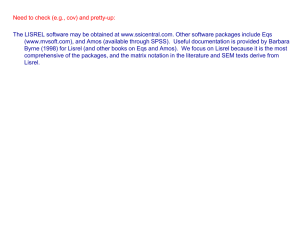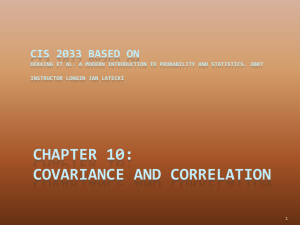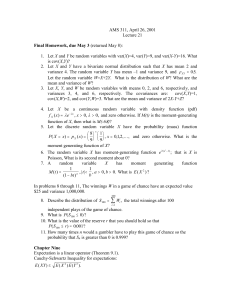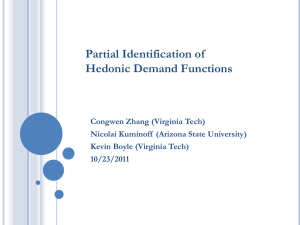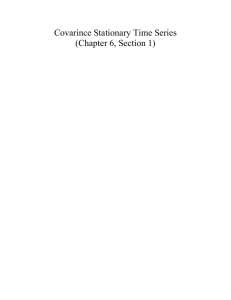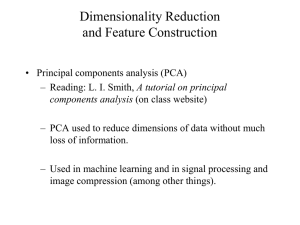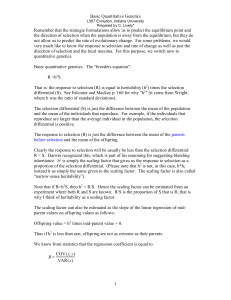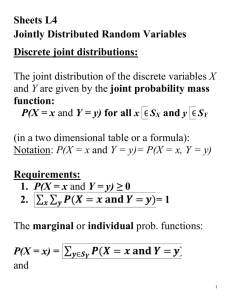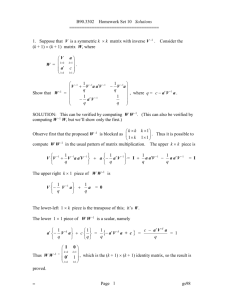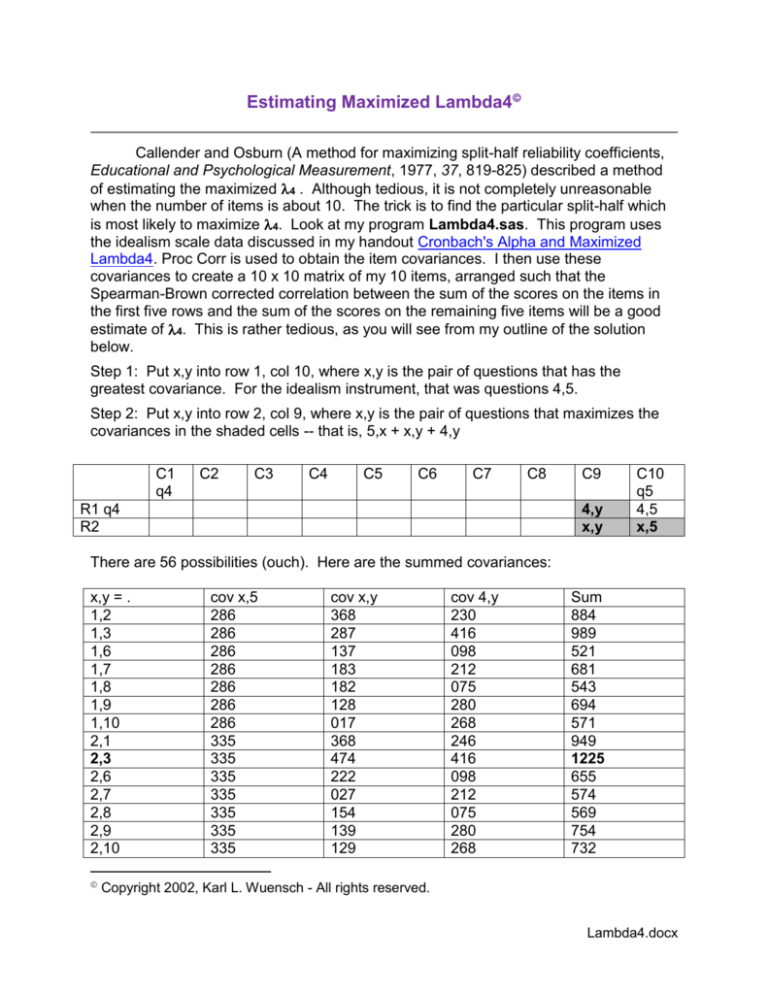
Estimating Maximized Lambda4
Callender and Osburn (A method for maximizing split-half reliability coefficients,
Educational and Psychological Measurement, 1977, 37, 819-825) described a method
of estimating the maximized 4 . Although tedious, it is not completely unreasonable
when the number of items is about 10. The trick is to find the particular split-half which
is most likely to maximize 4. Look at my program Lambda4.sas. This program uses
the idealism scale data discussed in my handout Cronbach's Alpha and Maximized
Lambda4. Proc Corr is used to obtain the item covariances. I then use these
covariances to create a 10 x 10 matrix of my 10 items, arranged such that the
Spearman-Brown corrected correlation between the sum of the scores on the items in
the first five rows and the sum of the scores on the remaining five items will be a good
estimate of 4. This is rather tedious, as you will see from my outline of the solution
below.
Step 1: Put x,y into row 1, col 10, where x,y is the pair of questions that has the
greatest covariance. For the idealism instrument, that was questions 4,5.
Step 2: Put x,y into row 2, col 9, where x,y is the pair of questions that maximizes the
covariances in the shaded cells -- that is, 5,x + x,y + 4,y
C1
q4
C2
C3
C4
C5
C6
C7
C8
R1 q4
R2
C9
4,y
x,y
C10
q5
4,5
x,5
There are 56 possibilities (ouch). Here are the summed covariances:
x,y = .
1,2
1,3
1,6
1,7
1,8
1,9
1,10
2,1
2,3
2,6
2,7
2,8
2,9
2,10
cov x,5
286
286
286
286
286
286
286
335
335
335
335
335
335
335
cov x,y
368
287
137
183
182
128
017
368
474
222
027
154
139
129
cov 4,y
230
416
098
212
075
280
268
246
416
098
212
075
280
268
Sum
884
989
521
681
543
694
571
949
1225
655
574
569
754
732
Copyright 2002, Karl L. Wuensch - All rights reserved.
Lambda4.docx
2
3,1
3,2
3,6
3,7
3,8
3,9
3,10
6,1
6,2
6,3
6,7
6,8
6,9
6,10
7,1
7,2
7,3
7,6
7.8
7,9
7,10
8,1
8,2
8,3
8,6
8,7
8,9
8,10
9,1
9,2
9.3
9,6
9,7
9,8
9,10
10,1
10,2
10,3
10,6
10,7
10,8
10,9
x,y = 2,3
374
374
374
374
374
374
374
202
202
202
202
202
202
202
119
119
119
119
119
119
119
209
209
209
209
209
209
209
301
301
301
301
301
301
301
147
147
147
147
147
147
147
289
287
307
221
199
413
149
137
222
307
042
090
134
014
183
027
221
042
075
296
112
181
158
199
090
075
343
027
128
139
413
134
296
343
183
018
129
149
014
112
027
183
246
230
098
212
075
280
268
246
230
416
212
075
280
268
246
230
416
098
075
280
268
246
230
416
098
212
280
268
246
230
416
098
212
075
268
246
230
416
098
212
075
280
909
891
779
807
648
1067
791
585
654
925
456
367
616
484
548
376
756
259
264
645
399
636
597
824
397
496
832
504
675
670
1130
535
809
719
752
191
506
712
259
471
249
610
3
Step3: Find x,y such that cov x,5 + x,3 + x,y + 2,y + 4,y is maximized. There are 30
possibilities
C1
q4
C2
q2
C3
C4
C5
C6
C7
R1 q4
R2 q2
R3
C8
4,y
2,y
x,y
C9
q3
4,3
2,3
x,3
C10
q5
4,5
2,5
x,5
There are 30 possibilities (ouch). Here are the summed covariances:
x,y
1,6
1,7
1,8
1,9
1,10
6,1
6,7
6,8
6,9
6,10
7,1
7,6
7,8
7,9
7,10
8,1
8,6
8,7
8,9
8,10
9,1
9,6
9,7
9,8
9,10
10,1
10,6
10,7
10,8
10,9
x,y is 9,1
cov x,5
286
286
286
286
286
202
202
202
202
202
119
119
119
119
119
209
209
209
209
209
301
301
301
301
301
147
147
147
147
147
cov x,3
287
287
287
287
287
307
307
307
307
307
221
221
221
221
221
199
199
199
199
199
413
413
413
413
413
149
149
149
149
149
cov x,y
137
183
182
128
017
137
042
090
134
014
183
042
075
296
112
182
090
075
343
027
128
134
296
343
183
017
014
112
027
183
cov 2,y
222
027
159
139
129
368
027
159
139
129
368
222
159
139
129
368
222
027
139
129
368
222
027
159
129
368
222
027
159
139
cov 4,y
098
212
075
280
268
246
212
075
280
268
246
098
075
280
268
246
098
212
280
268
246
098
212
075
268
246
098
212
075
280
Sum
1030
995
989
1120
987
1260
790
833
1062
920
1137
702
649
1055
849
1204
818
722
1170
832
1456
1168
1249
1291
1294
927
630
647
557
898
4
Step 4: Find x,y such that cov x,1 + x,3 + x,5 + x,y + 2,y + 4,y + 9,y is maximized
C1
q4
C2
q2
C3
C4
C5
C6
C7
R1 q4
R2 q2
R3 q9
R4
4,y
2,y
9,y
x,y
C8
q1
4,1
2,1
9,1
x,1
C9
q3
4,3
2,3
9,3
x,3
C10
q5
4,5
2,5
9,5
x,5
There are 12 possibilities Here are the summed covariances:
x,y =
6,7
6,8
6,10
7,6
7,8
7,10
8,6
8,7
8,10
10,6
10,7
10,8
cov x,1
137
137
137
183
183
183
182
182
182
017
017
017
cov x,3
307
307
307
221
221
221
199
199
199
149
149
149
cov x,5
202
202
202
119
119
119
209
209
209
147
147
147
cov x,y
042
090
014
042
075
112
090
075
027
014
112
027
cov 2,y
027
159
129
222
159
129
222
027
129
222
027
159
cov 4,y
212
075
268
098
075
268
098
212
268
098
212
075
cov 9,y
296
343
183
134
343
183
134
296
183
134
296
343
Sum
1223
1313
1240
1019
1175
1215
1134
1200
1197
781
960
917
x,y is 6,8
C1
q4
C2
q2
C3
q9
C4
q6
C5
C6
R1 q4
R2 q2
R3 q9
R4 q6
R5
4,y
2,y
9,y
6,y
x,y
C7
q8
4,8
2,8
9,8
6,8
x,8
C8
q1
4,1
2,1
9,1
6,1
x,1
C9
q3
4,3
2,3
9,3
6,3
x,3
C10
q5
4,5
2,5
9,5
6,5
x,5
Step 5: Find x,y to maximize the sum of covariances (cov (x,y) constant, so left out).
x,y =
7,10
10,7
x,1
183
017
x,y is 7,10.
x,3
221
149
x,5
119
147
x,8
075
027
2,y
129
027
4,y
268
212
6,y
014
042
9,y
183
296
Sum
1192
917
5
C1
q4
C2
q2
C3
q9
R1 q4
R2 q2
R3 q9
R4 q6
R5 q7
R6 q10
R7 q8
R8 q1
R9 q3
R10 q5
C4
q6
C5
q7
C6
q10
4,10
2,10
9,10
6,10
7,10
C7
q8
4,8
2,8
9,8
6,8
7,8
C8
q1
4,1
2,1
9,1
6,1
7,1
C9
q3
4,3
2,3
9,3
6,3
7,3
C10
q5
4,5
2,5
9,5
6,5
7,5
The split halves are now (2,4,6,7,9) vs (1,3,5,8,10). The program obtains the r between
these split halves is .70639. Applying the Spearman-Brown correction:
4
2r
2(.70639)
.828.
1 r
1.70639
Alternatively, using the variances obtained by the program,
4 21
12 22
8.196375 8.1238926
21
.828.
2
tot
27.8485906
A Similar Method That Can Be Used With Scales That Have More Items
H. G. Osburn (Coefficient alpha and related internal consistency reliability
coefficients, Psychological Methods, 2000, 5, 343-355) described a procedure "similar
to" that of Callender and Osburn (1977). Osburn was dealing with an 8 item instrument,
but I have employed it with scales having as many as 28 items. His description of the
method was terse. I quote "First, find the two components with the largest covariance.
Assign these two components to separate halves. Second, find the two components
with the next largest covariance and assign these to components to separate halves,
and so on until four pairs of components with the largest covariances are assigned to
separate halves."
This method is certainly simpler than that of Callender and Osburn, but I was
stumped with respect to which half to assign each member of each pair -- and it does
matter. For example, for the ten item measure of idealism, items 2 and 3 had the
highest covariance. I assigned item 2 to half A and item 3 to half B. The next highest
covariance was between items 4 and 5. Which half receives item 4, half A or half B? I
assigned it to B. I ended up with half A being comprised of items 2, 5, 8, 7, and 6, with
half B being comprised of items 3, 4, 9, 1, and 10. The resulting estimated maximum 4
was .783, somewhat less than the estimate from the more complicated procedure
6
explained above. This simpler method might be adequate when the number of items is
too large for the more complicated method to be feasible. I did email Osburn asking
him about how to decide into which half each item into a pair should be assigned, but I
never got a response.
I used this less complex method to estimate maximized 4 for the 28-item Animal
Rights scale also included in the KJ.dat file. The program I employed is Lambda4.sas,
which is available on my SAS programs page. The program computes Cronbach’s
alpha, obtains the covariances needed to construct the split-half that is used to estimate
maximized 4, and computes the correlation between the halves obtained.
The halves I employed are defined as variables A and B in the data step, but I
first needed to obtain the entire 28 x 28 covariance matrix. I got it one column at a time
to make it easier for me to sort it in a way that I could find the pair of items with the
highest covariance, the next highest pair, etc.
I brought the covariances into Word and removed all of the blanks on the left and
then replaced with tabs the blanks between item number and covariance. Then I
converted the text to table and sorted by column 2. I then used the sorted table to
assign variables to halves, following Osburn’s (2000) method.
The correlation between halves A and B was .87525, which yields an estimated
maximized 4 of .93348 after applying the Spearman-Brown correction. The Cronbach
alpha was .91.
The sorted table is 22 pages long, so I shall reproduce here only the top several
rows of the table.
q34
0.6915436242
q39
0.6915436242
q26
0.6758389262
q37
0.6758389262
q26
0.6285906040
q57
0.6285906040
q22
0.5975391499
q30
0.5975391499
q22
0.5894854586
q27
0.5894854586
q28
0.5864429530
q31
0.5864429530
q37
0.5724832215
q57
0.5724832215
Copyright 2002, Karl L. Wuensch - All rights reserved.

